Crude Slate, FCC Slurry Oil, Recycle, and Operating Conditions Effects on H-Oil® Product Quality
Abstract
1. Introduction
2. Results and Discussion
3. Materials and Methods
4. Conclusions
Author Contributions
Funding
Institutional Review Board Statement
Informed Consent Statement
Data Availability Statement
Acknowledgments
Conflicts of Interest
Nomenclature
| ATB | atmospheric tower bottom product |
| ARI | Aromatic ring index (average ring number) in the average EBVRHC heavy oil hydrocarbon structure; |
| CA | Aromatic carbon content, wt.% |
| CCR | Conradson carbon content, wt.% |
| CI | Cetane index |
| D15 | Density at 15 °C, g/cm3 |
| d | relative density at 15 °C, g/cm3 |
| EBVRHC | Ebullated bed vacuum residue hydrocracking |
| FCC | Fluid catalytic cracking |
| FR | H-Oil® unit trough-put (feed low rate), t/h |
| FRI20 | function of refractive index |
| H | hydrogen content, wt.% |
| HAGO | Heavy atmospheric gas oil |
| HCO | Heavy cycle oil |
| HTSD | High temperature simulated distillation |
| HVGO | Heavy vacuum gas oil |
| ICrA | InterCriteria Analysis |
| nd20 | refractive index |
| Kw | Watson characterization factor |
| Kwi | Watson characterization factor of the of ith pure component in the mixture |
| LNB | LUKOIL Neftohim Burgas refinery |
| LVGO | Light vacuum gas oil |
| μ | consonance |
| MW | molecular weight, g/mol |
| PBFO | Partially blended fuel oil |
| SG | specific gravity |
| SLO | Slurry oil |
| SRVRO | Straight run vacuum residual oil |
| T50F | boiling point of 50% of evaporate according to the HTSD, °F |
| Tb | normal boiling point or 50 wt % of evaporate according to the HTSD, K |
| T10 | boiling point of 10% of evaporate according to the HTSD, or physical distillation, °C |
| T30 | boiling point of 30% of evaporate according to the HTSD or physical distillation, °C |
| T50 | boiling point of 50% of evaporate according to the HTSD or physical distillation, °C |
| T70 | boiling point of 70% of evaporate according to the HTSD or physical distillation, °C |
| T90 | boiling point of 10% of evaporate according to the HTSD or physical distillation, °C |
| Rec. | per cent of PBFO recycle in the H-Oil® mixed feed, wt.%. |
| VGO | Vacuum gas oil |
| VTB | Vacuum tower bottom product (equivalent to unconverted hydrocracked vacuum residue) |
| WABT | average weight average bed temperature of both reactors in LNB H-Oil® unit, °C |
| VIS | kinematic viscosity at 80 °C, mm2/s |
| Xi | weight fraction of ith pure component in the mixture |
References
- Stratiev, D.; Nenov, S.; Shishkova, I.; Georgiev, B.; Argirov, G.; Dinkov, R.; Yordanov, D.; Atanassova, V.; Vassilev, P.; Atanassov, K. Commercial Investigation of the Ebullated-Bed Vacuum Residue Hydrocracking in the Conversion Range of 55–93%. ACS Omega 2020, 51, 33290. [Google Scholar] [CrossRef] [PubMed]
- Stratiev, D.; Nenov, S.; Shishkova, I.; Dinkov, R.; Argirov, G.; Georgiev, B.; Yordanov, D.; Atanassova, V.; Vassilev, P.; Atanassov, K. Non-linear least-squares method for modeling vacuum residue hydrocracking selectivity data. submitted for publication in Oxidation Communications.
- Stratiev, D.; Shishkova, I.; Ivanov, M.; Dinkov, R.; Georgiev, B.; Argirov, G.; Atanassova, V.; Vassilev, P.; Atanassov, K.; Yordanov, D.; et al. Catalytic cracking of diverse vacuum residue hydrocracking gas oils. Chem. Eng. Technol. 2021, 44, 1–13. [Google Scholar] [CrossRef]
- Stratiev, D.; Shishkova, I.; Ivanov, M.; Dinkov, R.; Georgiev, B.; Argirov, G.; Atanassova, V.; Vassilev, P.; Atanassov, K.; Yordanov, D.; et al. Role of Catalyst in Optimizing Fluid Catalytic Cracking Performance During Cracking of H-Oil-Derived Gas Oils. ACS Omega 2021, in press. [Google Scholar] [CrossRef] [PubMed]
- Dinkov, R.; Kirilov, K.; Stratiev, D. Feasibility of Bitumen Production from Unconverted Vacuum Tower Bottom from H-Oil Ebullated Bed Residue Hydrocracking. Ind. Eng. Chem. Res. 2018, 57, 2003. [Google Scholar] [CrossRef]
- Stratiev, D.; Shishkova, I.; Dinkov, R.; Kirilov, K.; Yordanov, D.; Nikolova, R.; Veli, A.; Tavlieva, M.; Vasilev, S.; Suyunov, R. Variation of Oxidation Reactivity of Straight Run and H-Oil Hydrocracked Vacuum Residual Oils in the Process of Road Asphalt Production. Road Mater. Pavement Des. 2021, 1–25. [Google Scholar] [CrossRef]
- Naghizada, N.; Prado, G.H.C.; de Klerk, A. Uncatalyzed Hydrogen Transfer during 100−250 °C Conversion of Asphaltenes. Energy Fuels 2017, 31, 6800–6811. [Google Scholar] [CrossRef]
- Stratiev, D.S.; Marinov, I.M.; Shishkova, I.K.; Dinkov, R.K.; Stratiev, D.D. Investigation on feasibility to predict the content of saturate plus mono-nuclear aromatic hydrocarbons in vacuum gas oils from bulk properties and empirical correlations. Fuel 2014, 129, 156–162. [Google Scholar] [CrossRef]
- Watson, K.M.; Nelson, E.F.; Murphy, G.B. Characterization of Petroleum Fractions. Ind. Eng. Chem. 1935, 27, 1460–1464. [Google Scholar] [CrossRef]
- Stratiev, D.; Shishkova, I.; Tsaneva, T.; Mitkova, M.; Yordanov, D. Investigation of relations between properties of vacuum residual oils from different origin, and of their deasphalted and asphaltene fractions. Fuel 2016, 170, 115–129. [Google Scholar] [CrossRef]
- Choudhary, T.V.; Meier, P.F. Characterization of heavy petroleum feedstocks. Fuel Process. Technol. 2008, 89, 697–703. [Google Scholar] [CrossRef]
- Herrera, P.S.; Oballa, M.C.; Somogyvari, A.F.; Monnier, J. Catalyst selection for hydrotreating diesel fuel from residue hydrocracking. ACS Prepr. 1992, 37, 1855–1863. [Google Scholar]
- Wandas, R.; Chrapek, T. Hydrotreating of middle distillates from destructive petroleum processing over high-activity catalysts to reduce nitrogen and improve the quality. Fuel Process. Technol. 2004, 85, 1333–1343. [Google Scholar] [CrossRef]
- Tomášek, J.; Matĕjovský, L.; Lamblová, M.; Blažek, J. Properties and Composition of Products from Hydrotreating of Straight-Run Gas Oil and Its Mixtures with Light Cycle Oil over Sulfidic Ni-Mo/Al2O3 Catalyst. ACS Omega 2020, 5, 27922–27932. [Google Scholar] [CrossRef] [PubMed]
- Dinkov, R.; Stratiev, D. Studying The Evolution of H-OIL Hydrocracked Residual Oil Properties In The Conversion Range 65–93%, and the Opportunity To Produce Road Asphalt From H-OIL VTB. Oxid. Commun. 2021, 5, 33290–33304. [Google Scholar]
- Gharagheizi, F.; Fazeli, A. Prediction of the Watson Characterization Factor of Hydrocarbon Components from Molecular Properties. QSAR Comb. Sci. 2008, 27, 758–767. [Google Scholar] [CrossRef]
- Chabot, J.; Shiflett, W. Residuum Hydrocracking: Chemistry and Catalysis. Available online: https://www.digitalrefining.com/article/1002340/residuum-hydrocracking-chemistry-and-catalysis#.YK9AZaFRVPY (accessed on 6 April 2021).
- Sánchez, S.; Rodríguez, M.A.; Ancheyta, J. Kinetic model for moderate hydrocracking of heavy oils. Ind. Eng. Chem. Res. 2005, 44, 9409–9413. [Google Scholar] [CrossRef]
- Loria, H.; Trujillo-Ferrer, G.; Sosa-Stull, C.; Pereira-Almao, P. Kinetic modeling of bitumen hydroprocessing at in-reservoir conditions employing ultradispersed catalysts. Energy Fuels 2011, 25, 1364–1372. [Google Scholar] [CrossRef]
- Martínez, J.; Ancheyta, J. Kinetic model for hydrocracking of heavy oil in a CSTR involving short term catalyst deactivation. Fuel 2012, 100, 193–199. [Google Scholar] [CrossRef]
- Asaee, S.D.S.; Vafajoo, L.; Khorasheh, F. A new approach to estimate parameters of a lumped kinetic model for hydroconversion of heavy residue. Fuel 2014, 134, 343–353. [Google Scholar] [CrossRef]
- Sharafutdinov, I.; Stratiev, D.; Shishkova, I.; Dinkov, R.; Pavlova, A.; Petkov, P.; Rudnev, N. Dependence of cetane index on aromatic content in diesel fuels. OGEM 2012, 38, 148–152. [Google Scholar]
- Goossens, A.G. Prediction of Molecular Weight of Petroleum Fractions. Ind. Eng. Chem. Res. 1996, 35, 985. [Google Scholar] [CrossRef]
- Abutaqiya, M. Advances in Thermodynamic Modeling of Nonpolar Hydrocarbons and Asphaltene Precipitation in Crude Oils. Ph.D. Thesis, Rice University, Houston, TX, USA, 2019. [Google Scholar]
- Stratiev, D.; Shishkova, I.; Tankov, I.; Pavlova, A. Challenges in characterization of residual oils. A review. J. Petrol. Sci. Eng. 2019, 178, 227–250. [Google Scholar] [CrossRef]
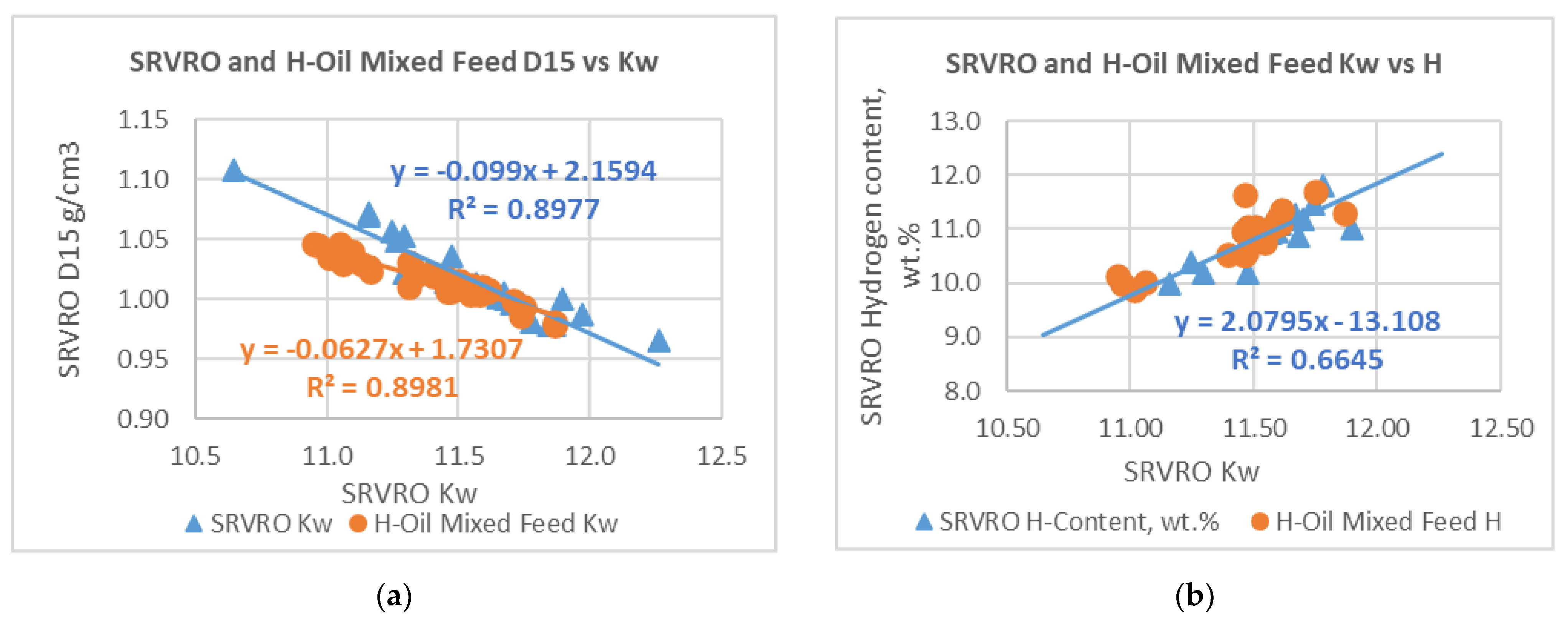
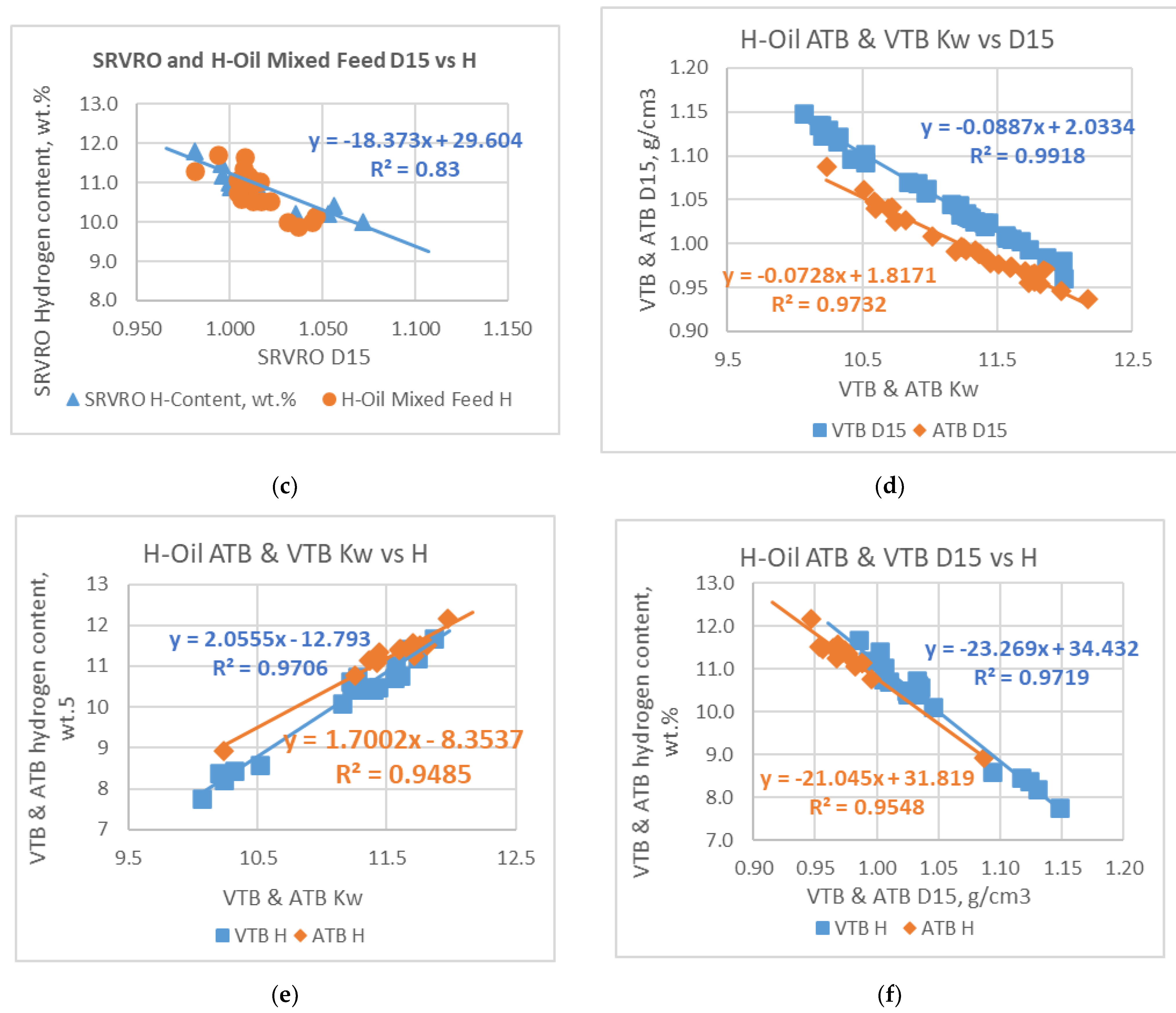
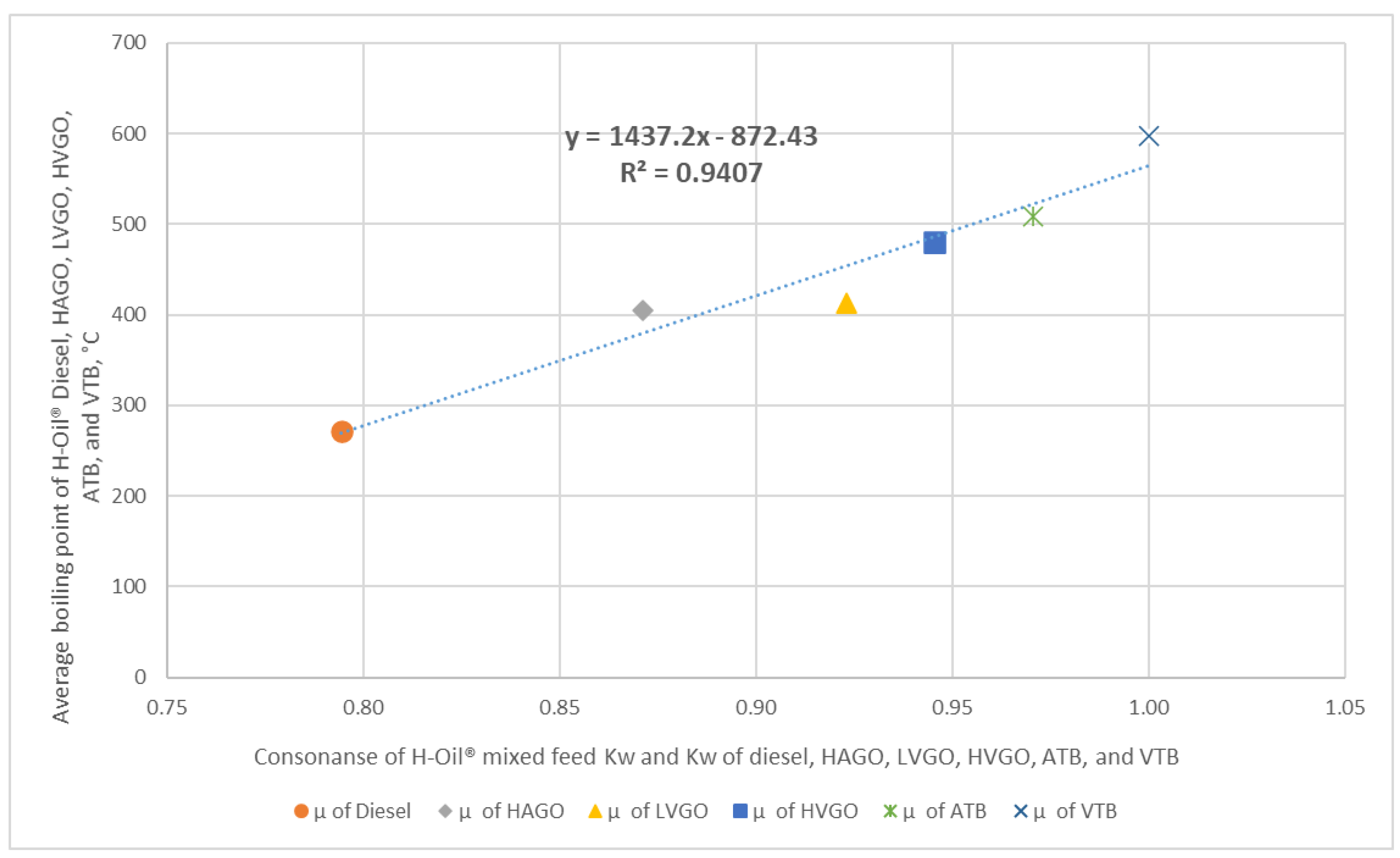
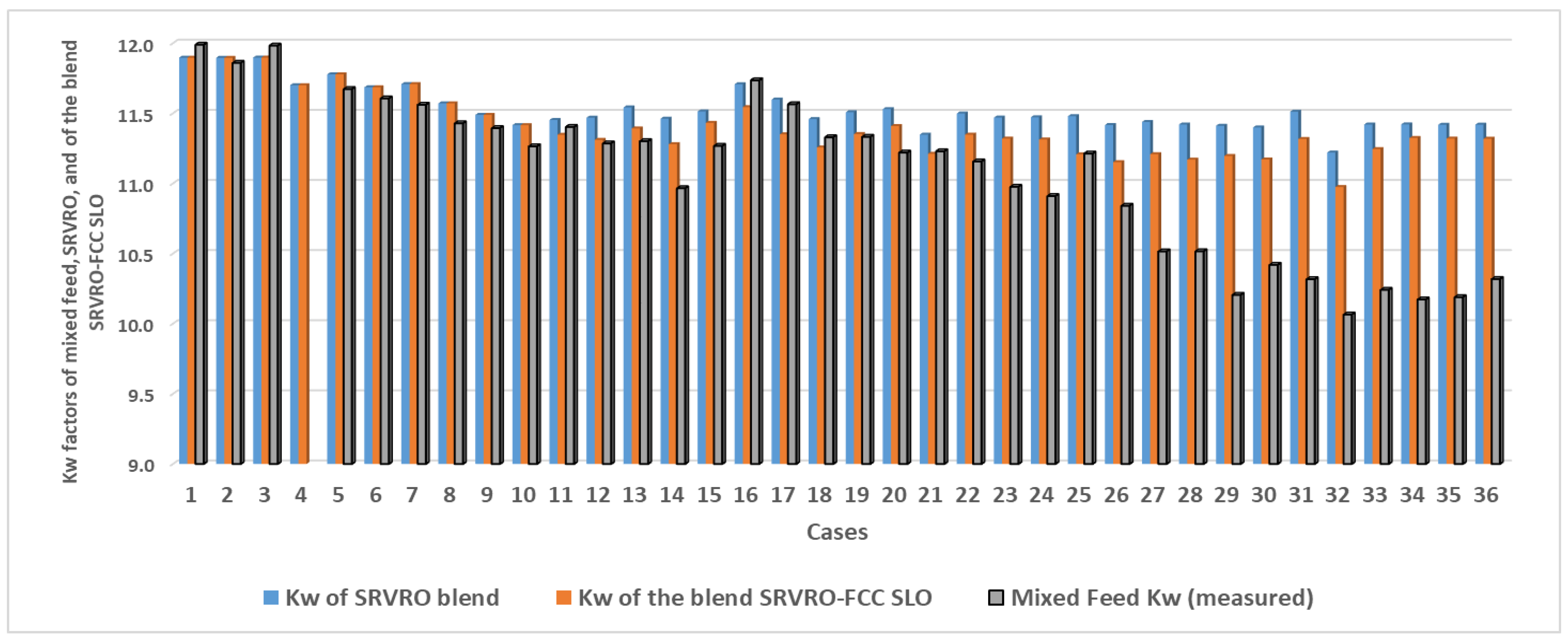


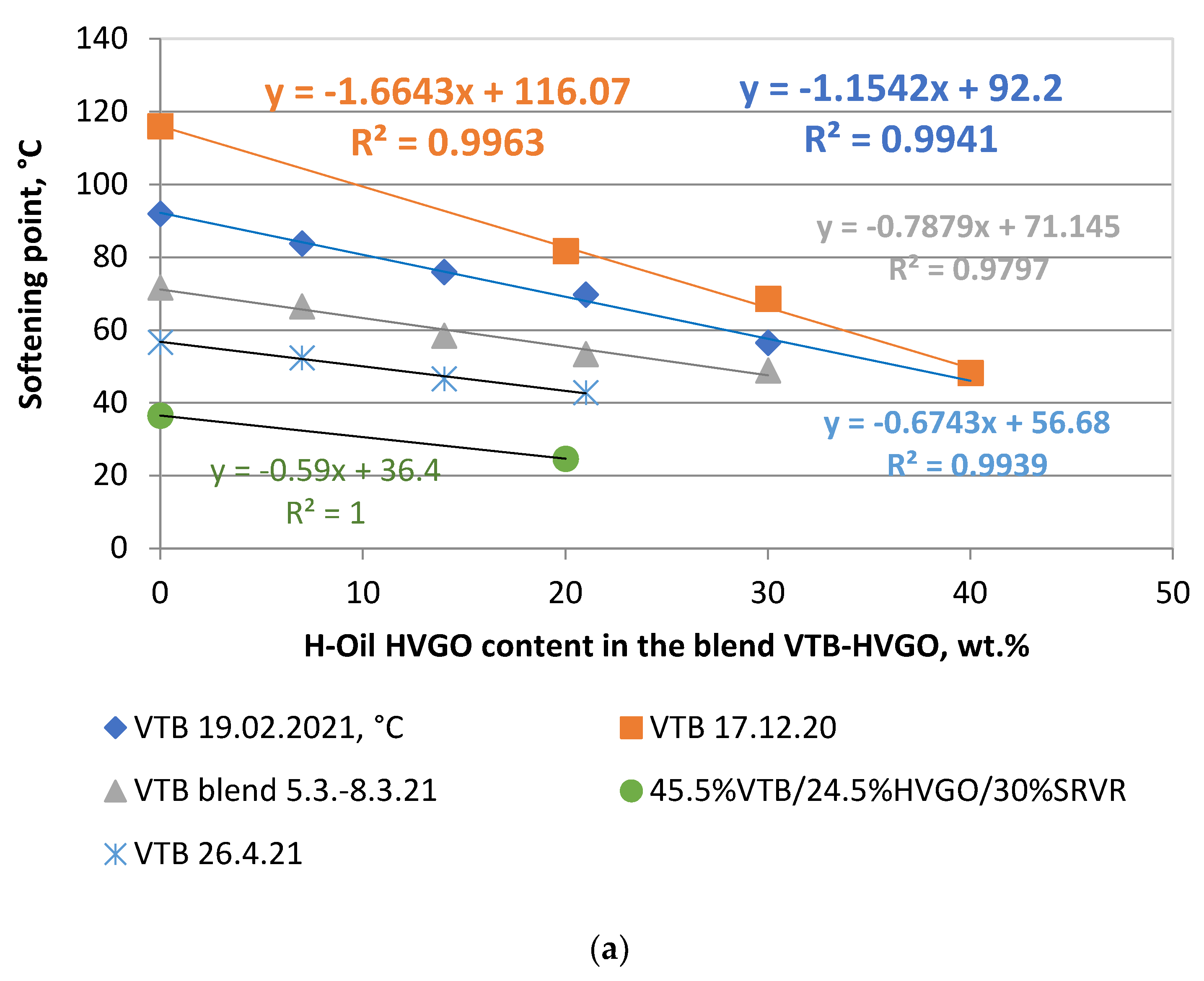

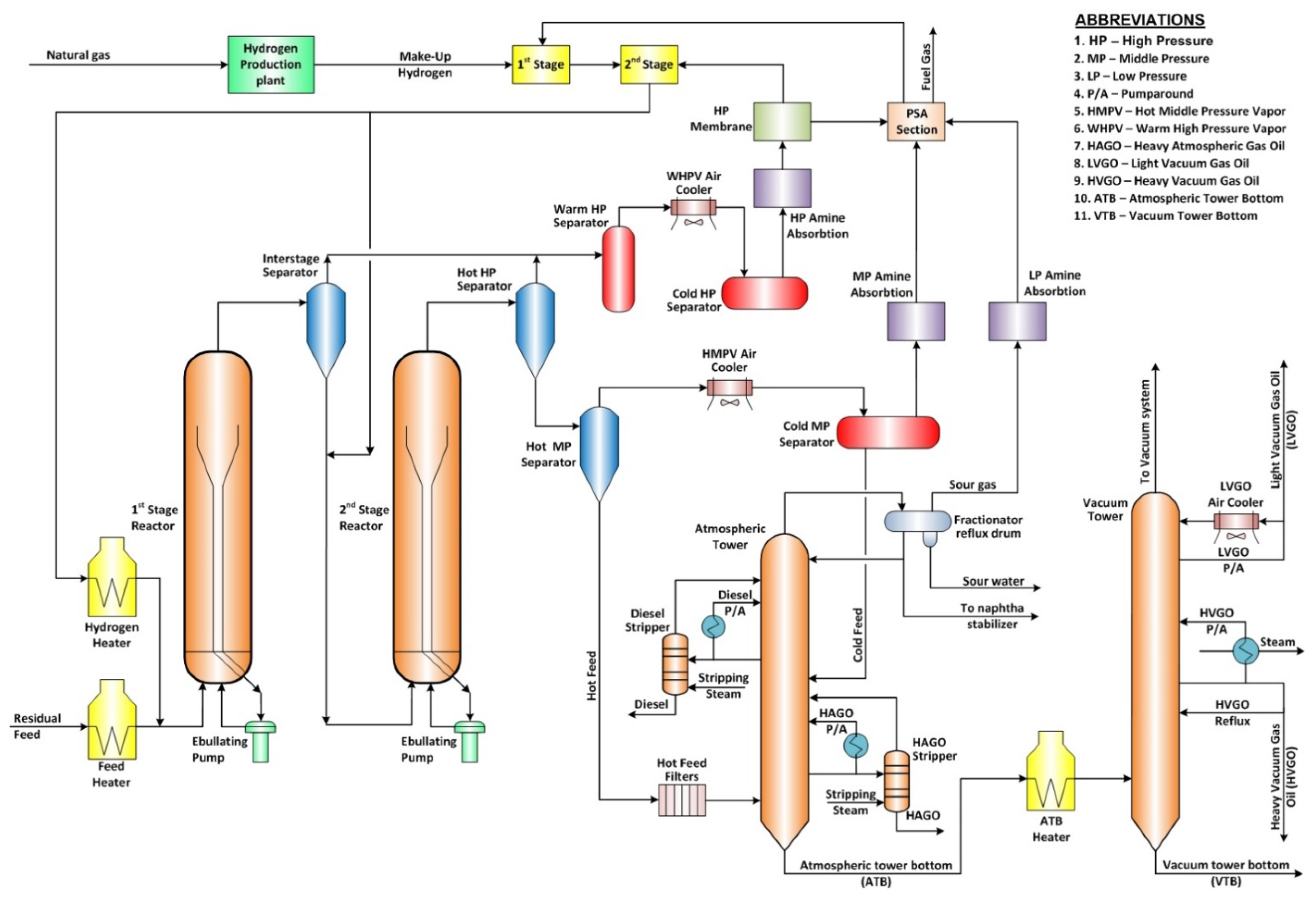
| HAGO Kw | HAGO ARI | HAGO CA | HAGO H | HAGO D15 | LVGO D15 | LVGO Kw | LVGO CA | LVGO H | LVGO ARI | HVGO Kw | HVGO CA | HVGO H | HVGO D15 | HVGO ARI | |
|---|---|---|---|---|---|---|---|---|---|---|---|---|---|---|---|
| HAGO Kw | 1.00 | ||||||||||||||
| HAGO ARI | 0.05 | 1.00 | |||||||||||||
| HAGO CA | 0.00 | 0.96 | 1.00 | ||||||||||||
| HAGO H | 0.99 | 0.02 | 0.00 | 1.00 | |||||||||||
| HAGO D15 | 0.02 | 0.99 | 0.99 | 0.00 | 1.00 | ||||||||||
| LVGO D15 | 0.02 | 0.97 | 0.99 | 0.01 | 0.99 | 1.00 | |||||||||
| LVGO Kw | 0.99 | 0.08 | 0.02 | 0.97 | 0.03 | 0.02 | 1.00 | ||||||||
| LVGO CA | 0.01 | 0.94 | 0.99 | 0.02 | 0.98 | 0.99 | 0.00 | 1.00 | |||||||
| LVGO H | 0.99 | 0.04 | 0.01 | 0.99 | 0.01 | 0.00 | 0.99 | 0.00 | 1.00 | ||||||
| LVGO ARI | 0.05 | 0.98 | 0.96 | 0.03 | 0.98 | 0.98 | 0.07 | 0.95 | 0.03 | 1.00 | |||||
| HVGO Kw | 0.93 | 0.11 | 0.07 | 0.93 | 0.02 | 0.04 | 0.97 | 0.03 | 0.96 | 0.11 | 1.00 | ||||
| HVGO CA | 0.07 | 0.90 | 0.93 | 0.07 | 0.93 | 0.96 | 0.03 | 0.97 | 0.03 | 0.90 | 0.00 | 1.00 | |||
| HVGO H | 0.93 | 0.09 | 0.06 | 0.94 | 0.06 | 0.04 | 0.97 | 0.03 | 0.97 | 0.09 | 0.99 | 0.00 | 1.00 | ||
| HVGO D15 | 0.07 | 0.91 | 0.94 | 0.06 | 0.94 | 0.97 | 0.03 | 0.97 | 0.03 | 0.92 | 0.01 | 1.00 | 0.00 | 1.00 | |
| HVGO ARI | 0.06 | 0.94 | 0.95 | 0.04 | 0.96 | 0.97 | 0.05 | 0.96 | 0.03 | 0.94 | 0.06 | 0.05 | 0.03 | 0.98 | 1.00 |
| H-Oil Liquid Products Properties | Range | Mixed Feed | Naphtha | Diesel | ATB | HAGO | LVGO | HVGO | VTB |
|---|---|---|---|---|---|---|---|---|---|
| Sulphur, wt.% | Min | 2.55 | 0.02 | 0.08 | 0.59 | 0.36 | 0.41 | 0.50 | 0.94 |
| Max | 3.92 | 0.04 | 0.27 | 1.36 | 0.76 | 0.89 | 1.17 | 2.21 | |
| Density at 15 °C, g/cm3 | Min | 0.979 | 0.698 | 0.841 | 0.915 | 0.899 | 0.902 | 0.921 | 0.961 |
| Max | 1.046 | 0.727 | 0.875 | 1.087 | 0.958 | 0.985 | 1.013 | 1.148 | |
| Kw-charaterzing factor | Min | 10.9 | 12.0 | 11.4 | 10.2 | 11.1 | 10.9 | 10.9 | 10.1 |
| Max | 11.9 | 12.5 | 12.1 | 12.2 | 11.9 | 11.9 | 12.0 | 12.0 | |
| Diesel Cetane Index | Min | - | - | 38.2 | - | - | - | - | - |
| Max | - | - | 67.1 | - | - | - | - | - | |
| Hydrogen content, wt.% | Min | 9.9 | - | - | 8.9 | 11 | 10.3 | 9.8 | 7.8 |
| Max | 11.7 | - | - | 12.2 | 12.6 | 12.5 | 12.2 | 11.7 | |
| Micro carbon residue, wt.% | Min | 12 | - | - | - | - | - | - | 17.9 |
| Max | 23.6 | - | - | - | - | - | - | 45.6 | |
| C5 asphaltenes, wt.% | Min | 9.3 | - | - | - | - | - | - | 21.8 |
| Max | 28.5 | - | - | - | - | - | - | 91 | |
| C7 asphaltenes, wt.% | Min | 7.2 | - | - | 2.7 | - | - | - | 12.1 |
| Max | 26.7 | - | - | 17.3 | - | - | - | 67 | |
| Nitrogen content, wt.% | Min | 0.21 | - | - | 0.34 | - | - | - | 0.36 |
| Max | 0.52 | - | - | 0.61 | - | - | - | 0.86 | |
| Nickel, ppm | Min | 38 | - | - | - | - | - | - | 19 |
| Max | 75 | - | - | - | - | - | - | 84 | |
| Vanadium, ppm | Min | 110 | - | - | - | - | - | - | 39 |
| Max | 245 | - | - | - | - | - | - | 191 | |
| Sodium, ppm | Min | 12 | - | - | - | - | - | - | 7 |
| Max | 41 | - | - | - | - | - | - | 95 | |
| Iron, ppm | Min | 4 | - | - | - | - | - | - | 0.3 |
| Max | 69 | - | - | - | - | - | - | 113 | |
| Diesel Mono-Aromatic Hydrocarbons, wt.% | Min | - | - | - | 21.9 | - | - | - | - |
| Max | - | - | - | 37.6 | - | - | - | - | |
| Diesel Di-Aromatic Hydrocarbons, wt.% | Min | - | - | - | 3.9 | - | - | - | - |
| Max | - | - | - | 10.9 | - | - | - | - | |
| Diesel Tri-Aromatic Hydrocarbons, wt.% | Min | - | - | - | 0.7 | - | - | - | - |
| Max | - | - | - | 12.2 | - | - | - | - | |
| MW, g/mol | Min | 492 | - | - | 323 | 271 | 286 | 343 | 482 |
| Max | 683 | - | - | 583 | 341 | 348 | 440 | 737 | |
| CA, wt.% | Min | - | - | - | - | 17.4 | 19 | 18.1 | - |
| Max | - | - | - | - | 36 | 42.5 | 45.4 | - | |
| Aromatic ring index | Min | 4.1 | - | - | 1.6 | 1.3 | 1.4 | 1.9 | 3.5 |
| Max | 5.4 | - | - | 4.3 | 2.1 | 2.5 | 3.4 | 6.5 |
| FR | WABT | Rec. | VTB D15 | Diesel Kw | HAGO Kw | LVGO Kw | HVGO Kw | ATB Kw | Feed Kw | |
|---|---|---|---|---|---|---|---|---|---|---|
| FR | 1.00 | - | - | - | - | - | - | - | - | - |
| WABT | 0.43 | 1.00 | - | - | - | - | - | - | - | - |
| Rec. | 0.33 | 0.55 | 1.00 | - | - | - | - | - | - | |
| VTB D15 | 0.29 | 0.87 | 0.75 | 1.00 | - | - | - | - | - | - |
| Diesel Kw | 0.79 | 0.22 | 0.46 | 0.22 | 1.00 | - | - | - | - | - |
| HAGO Kw | 0.68 | 0.08 | 0.48 | 0.14 | 0.82 | 1.00 | - | - | - | |
| LVGO Kw | 0.72 | 0.10 | 0.50 | 0.08 | 0.79 | 0.99 | 1.00 | - | - | - |
| HVGO Kw | 0.74 | 0.11 | 0.21 | 0.07 | 0.78 | 0.93 | 0.97 | 1.00 | - | - |
| ATB Kw | 0.73 | 0.13 | 0.19 | 0.04 | 0.77 | 0.86 | 0.94 | 0.96 | 1.00 | - |
| Feed Kw | 0.72 | 0.12 | 0.22 | 0.00 | 0.79 | 0.87 | 0.92 | 0.95 | 0.97 | 1.00 |
| VTB D15 | VTB CCR | VTB VIS (70%VR/30%HCO) at 80 °C, mm2/s | Softening Point, °C | |
|---|---|---|---|---|
| VTB D15, g/cm3 | 1.00 | - | - | - |
| VTB CCR, wt.% | 0.99 | 1.00 | - | - |
| VTB VIS (70%VTB/30%HCO) at 80 °C, mm2/s | 0.92 | 0.95 | 1.00 | |
| Softening point, °C | 0.95 | 0.95 | 0.96 | 1.00 |
| Case | Trough-Put, t/h | WABT, °C | FCC SLO, wt.% of Feed | Recycle, wt.% of Feed | Recycle Gas/Oil Ratio, R-1001 kg/t | Recycle Gas Hydrogen Content, wt (vol.) % | Net Conversion, wt.% | First Reactor Inlet Pressure, Bar | First Reactor Inlet H2 Partial Pressure, Bar |
|---|---|---|---|---|---|---|---|---|---|
| 1 | 313 | 418 | 0 | 0 | 20.6 | 95.7 | 65.0 | 173 | 166 |
| 2 | 285 | 410 | 0 | 0 | - | - | 55.0 | 174 | - |
| 3 | 279 | 411 | 0 | 0 | 24.4 | 95.6 | 54.7 | 173 | 166 |
| 4 | 306 | 414 | 0 | 0 | 21.8 | 89 | 56.1 | 174 | 155 |
| 5 | 293 | 418 | 0 | 0 | 21.8 | 97.7 | 67.3 | 173 | 169 |
| 6 | 172 | 419 | 0 | 0 | 37.3 | 97.7 | 76.8 | 173 | 169 |
| 7 | 239 | 420 | 0 | 0 | 28.7 | 97 | 71.2 | 173 | 168 |
| 8 | 240 | 418 | 0 | 0 | 29.4 | 97.5 | 70.1 | 173 | 169 |
| 9 | 230 | 419 | 0 | 0 | 30.1 | 97.6 | 67.5 | 174 | 170 |
| 10 | 208 | 423 | 0 | 0 | 33.2 | 97 | 72.9 | 174 | 168 |
| 11 | 244 | 424 | 0 | 0 | 22.5 | 97.6 | 72.5 | 174 | 169 |
| 12 | 245 | 426 | 8 | 0 | 22.5 | 97.6 | 75.3 | 174 | 169 |
| 13 | 263 | 427 | 8 | 0 | - | - | 70.7 | 173 | - |
| 14 | 266 | 430 | 9 | 0 | 19.8 | 97.4 | 74.3 | 173 | 169 |
| 15 | 236 | 417 | 4 | 0 | 24.6 | 98.3 | 63.4 | 173 | 170 |
| 16 | 224 | 414 | 9 | 0 | 29.1 | 98.5 | 60.4 | 173 | 171 |
| 17 | 195 | 417 | 12 | 0 | 33.6 | 99.3 | 67.3 | 173 | 171 |
| 18 | 227 | 425 | 10 | 0 | 29.6 | 99.1 | 71.7 | 174 | 172 |
| 19 | 247 | 426 | 8 | 0 | 29.8 | - | 75.1 | 174 | - |
| 20 | 250 | 425 | 6 | 0 | 28.0 | 93 | 72.9 | 173 | 161 |
| 21 | 214 | 426 | 8 | 0 | 16.0 | 92.3 | 76.3 | 174 | 160 |
| 22 | 256 | 427 | 8 | 0 | 26.1 | 90.8 | 74.1 | 174 | 158 |
| 23 | 257 | 433 | 8 | 0 | 26.0 | 88.8 | 79.0 | 174 | 154 |
| 24 | 242 | 433 | 8 | 0 | - | - | 80.8 | 174 | - |
| 25 | 225 | 433 | 14 | 0 | 28.5 | 87.7 | 80.3 | 173 | 152 |
| 26 | 142 | 429 | 14 | 10 | 43.0 | 87.1 | 85.9 | 173 | 151 |
| 27 | 127 | 430 | 12 | 10.0 | - | - | 90.3 | 173 | - |
| 28 | 123 | 431 | 13 | 29.4 | 51.7 | 92.5 | 93.2 | 173 | 160 |
| 29 | 128 | 433 | 11 | 27 | 44.9 | 86.9 | 92.6 | 173 | 150 |
| 30 | 126 | 433 | 12 | 26 | 47.8 | 90.2 | 91.1 | 173 | 156 |
| 31 | 140 | 434 | 11 | 18 | 44.7 | 89.9 | 91.1 | 173 | 155 |
| 32 | 146 | 434 | 14 | 21 | 39.5 | 82.4 | 87.5 | 173 | 142 |
| 33 | 156 | 432 | 9 | 22 | 40.2 | 87.5 | 89.5 | 172 | 151 |
| 34 | 182 | 435 | 4.9 | 19.2 | - | - | 86.2 | 172 | - |
| 35 | 178 | 435 | 5.0 | 9.8 | 35.4 | 89.8 | 87.2 | 172 | 155 |
| 36 | 175 | 436 | 5.1 | 0.0 | 35.5 | 87.4 | 85.2 | 172 | 151 |
| Density of Mixed Feed, g/cm3 | BDS EN ISO 3675 |
|---|---|
| Sulfur of mixed feed, ATB, VTB, HAGO, LVGO, HVGO, Diesel wt.% | ASTM D 4294 |
| Asphaltene (C7, and C5) content, wt.% | ASTM D 6560 |
| Micro carbon content, wt.% | EN ISO 10370 |
| Specific viscosity, °E | ASTM D1665 |
| Carbon content, wt.% | ASTM D 5291 |
| Hydrogen content, wt.% | ASTM D 5291 |
| Nitrogen content, wt.% | ASTM D 5291 |
| Nickel, ppm | IP 501 |
| Vanadium, ppm | IP 501 |
| Sodium, ppm | IP 501 |
| Iron, ppm | IP 501 |
| High temperature simulation distillation (HTSD) | ASTM D7169 |
| Density of naphtha, g/cm3 | BDS EN ISO 12185 |
| Sulfur of naphtha, ppm | BDS EN ISO 20846 |
| Distillation of naphtha and diesel | BDS EN ISO 3405 |
| Density of diesel, g/cm3 | BDS EN ISO 3675 |
| Diesel Aromatic hydrocarbons, wt.% | BDS EN 12916 |
| Diesel Cetane Index | ASTM D4737 |
Publisher’s Note: MDPI stays neutral with regard to jurisdictional claims in published maps and institutional affiliations. |
© 2021 by the authors. Licensee MDPI, Basel, Switzerland. This article is an open access article distributed under the terms and conditions of the Creative Commons Attribution (CC BY) license (https://creativecommons.org/licenses/by/4.0/).
Share and Cite
Stratiev, D.S.; Shishkova, I.K.; Dinkov, R.K.; Petrov, I.P.; Kolev, I.V.; Yordanov, D.; Sotirov, S.; Sotirova, E.N.; Atanassova, V.K.; Ribagin, S.; et al. Crude Slate, FCC Slurry Oil, Recycle, and Operating Conditions Effects on H-Oil® Product Quality. Processes 2021, 9, 952. https://doi.org/10.3390/pr9060952
Stratiev DS, Shishkova IK, Dinkov RK, Petrov IP, Kolev IV, Yordanov D, Sotirov S, Sotirova EN, Atanassova VK, Ribagin S, et al. Crude Slate, FCC Slurry Oil, Recycle, and Operating Conditions Effects on H-Oil® Product Quality. Processes. 2021; 9(6):952. https://doi.org/10.3390/pr9060952
Chicago/Turabian StyleStratiev, Dicho Stoyanov, Ivelina Kostova Shishkova, Rosen Kocev Dinkov, Ivan Petrov Petrov, Iliyan Venkov Kolev, Dobromir Yordanov, Sotir Sotirov, Evdokia Nikolaeva Sotirova, Vassia Krassimirova Atanassova, Simeon Ribagin, and et al. 2021. "Crude Slate, FCC Slurry Oil, Recycle, and Operating Conditions Effects on H-Oil® Product Quality" Processes 9, no. 6: 952. https://doi.org/10.3390/pr9060952
APA StyleStratiev, D. S., Shishkova, I. K., Dinkov, R. K., Petrov, I. P., Kolev, I. V., Yordanov, D., Sotirov, S., Sotirova, E. N., Atanassova, V. K., Ribagin, S., Atanassov, K. T., Stratiev, D. D., & Nenov, S. (2021). Crude Slate, FCC Slurry Oil, Recycle, and Operating Conditions Effects on H-Oil® Product Quality. Processes, 9(6), 952. https://doi.org/10.3390/pr9060952










